
St Martin in the Bull Ring is a Church of England parish church in the city of Birmingham, West Midlands, England. It is the original parish church of Birmingham and stands between the Bull Ring Shopping Centre and the markets.

St Peter's Church is a Church of England parish church located in the centre of Bournemouth, Dorset, England. It is a Grade I listed building classed as a 'major parish church', and was completed in 1879 to a design by George Edmund Street as the founding mother church of Bournemouth.

St Peter's Church, formally The Church of St Peter with St James, is an Anglican parish church in the city centre of Nottingham, England. It is part of the parish of All Saints', St Mary's and St Peter's, Nottingham.
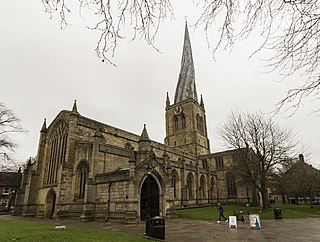
Chesterfield Parish Church is an Anglican church dedicated to Saint Mary and All Saints, in Chesterfield, Derbyshire, England. Building of the church began in 1234 AD, though the present church dates predominantly from the 14th century. Designated a Grade I listed building in 1971, St Mary's is best known for its twisted and leaning spire. It is the largest parish church in the Diocese of Derby and forms part of the Archdeaconry of Chesterfield. In 1994, it also became the UK's only representative in the Association of the Twisted Spires of Europe; of the 72 member churches, it is deemed to have the greatest lean and twist.
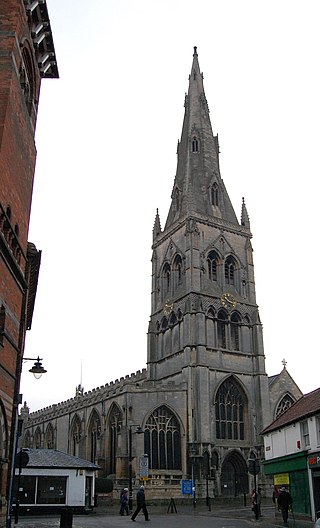
St Mary Magdalene Church, Newark-on-Trent is the parish church of Newark-on-Trent in Nottinghamshire, England. It is dedicated to Mary Magdalene and is the tallest structure in the town.
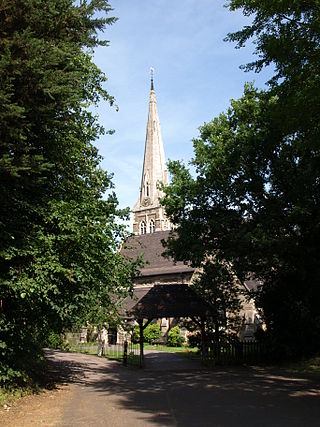
St. Mary's Church, Selly Oak is a Church of England parish church in Selly Oak, Birmingham, England.

St. Stephen's Church, Sneinton is a parish church in the Church of England.

St James' Church, Louth, is the Anglican parish church of Louth in Lincolnshire, England. It is notable for having the third tallest spire in the whole of the United Kingdom. The church was the site of the Lincolnshire Rising, starting in October 1536 and led by the vicar, who was drawn and quartered for his actions.

St Martin's Church, Stamford, is a Grade I listed parish church in the Church of England located in Stamford, Lincolnshire, England. The area of the town south of the River Welland was in Northamptonshire until 1889 and is called Stamford Baron or St Martin's.
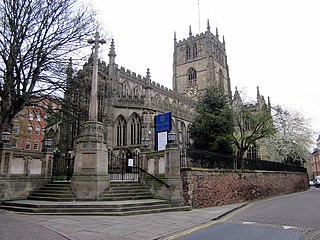
The Church of St Mary the Virgin is the oldest parish church of Nottingham, in Nottinghamshire, England. The church is Grade I listed by the Department for Digital, Culture, Media and Sport as a building of outstanding architectural or historic interest. It is one of only five Grade I listed buildings in the City of Nottingham.

All Saints' Church, Oakham is a parish church in the Church of England in Oakham, Rutland. It is Grade I listed.
St. Paul's Church, George Street, was a Church of England church built as a chapel of ease to St. Mary's Church, Nottingham. It was opened in 1822 and closed in 1924.
St. James' Church, Standard Hill was a Church of England church in Nottingham.
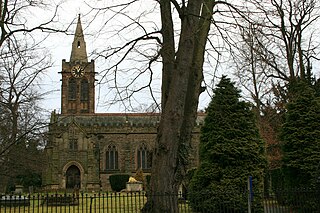
St. Peter's Church is a Church of England church in Ruddington, Nottinghamshire.

St Mary and All Saints’ Church, Kidderminster is a Grade I listed Major Parish Church in the Church of England in Kidderminster, Worcestershire, England.

Holy Trinity Parish Church is the parish church of Sutton Coldfield, West Midlands, England. It is Grade I listed and gives its name to the ward in which it stands, Sutton Trinity.
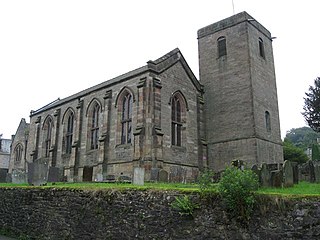
St John the Baptist's Church, Winster is a Grade II listed parish church in the Church of England in Winster, Derbyshire.

St Peter's Church, Belper is a Grade II listed parish church in the Church of England in Belper, Derbyshire.

The Church of St John the Apostle, Torquay, is a Grade I listed parish church in the Church of England Diocese of Exeter on Montpellier Road in Torquay, Devon.

St Cuthbert's Church, Darlington is a parish church in the Church of England Diocese of Durham in Darlington, County Durham.





















